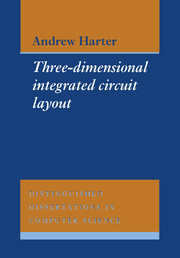Book contents
- Frontmatter
- Abstract
- Preface
- Contents
- List of Figures
- List of Plates
- List of Tables
- List of Algorithms
- Glossary of Terms
- 1 Introduction
- 2 Two-Dimensional Chip Design
- 3 Three-Dimensional Chip Technology
- 4 Three-Dimensional Circuit Topology
- 5 Three-Dimensional Cell Tessellation
- 6 Three-Dimensional Abutment System
- 7 Abutment System Configuration
- 8 Abutment System Evaluation
- 9 Conclusions
- A Layout Editor Configuration
- B Layout System Data Structures
- C Cell Description Rules
- D Circuits
- References
- Index
2 - Two-Dimensional Chip Design
Published online by Cambridge University Press: 05 May 2010
- Frontmatter
- Abstract
- Preface
- Contents
- List of Figures
- List of Plates
- List of Tables
- List of Algorithms
- Glossary of Terms
- 1 Introduction
- 2 Two-Dimensional Chip Design
- 3 Three-Dimensional Chip Technology
- 4 Three-Dimensional Circuit Topology
- 5 Three-Dimensional Cell Tessellation
- 6 Three-Dimensional Abutment System
- 7 Abutment System Configuration
- 8 Abutment System Evaluation
- 9 Conclusions
- A Layout Editor Configuration
- B Layout System Data Structures
- C Cell Description Rules
- D Circuits
- References
- Index
Summary
Abstraction and automation
Goals
The goal of the chip design problem is the specification in absolute units of the precise geometric content of each mask in a particular fabrication process, such that the integrated circuits created by the application of the masks exhibit the intended function. This specification forms the interface between the design and fabrication domains. The intersection of shapes in the set of masks characterises the circuit by determining the nature, location and size of devices and wiring. At the final stage the specification will be a stream of data suitable for either driving mask making equipment or controlling a direct write device.
As the scale of integration increases, so does the complexity of the design problem. The huge volumes of data involved stretch to the limit the human capability to specify a functionally correct layout in reasonable time. An individual's ability to conceive a complex design and successfully translate it into the very detailed information required for mask making is doubtful. The introduction of abstraction is an essential element in chip design. Abstraction is the process of symbolising concepts by extracting common qualities from individual cases. The power of computer automation can then be applied to manipulate the symbols of abstractions.
Axioms
Properties of materials and devices for a particular process can be derived empirically from observations and measurements made in the fabrication plant. These properties are taken to be axiomatic to the chip design problem. There are two sets of such axioms. The first set describe the properties and behaviour of semiconductor and wiring materials in particular configurations.
- Type
- Chapter
- Information
- Three-Dimensional Integrated Circuit Layout , pp. 15 - 34Publisher: Cambridge University PressPrint publication year: 1991



